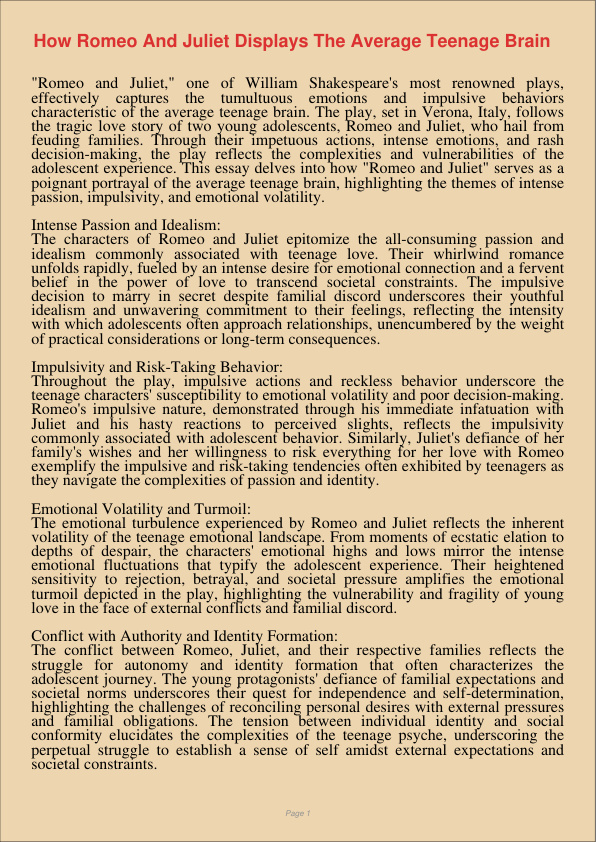How Romeo And Juliet Displays The Average Teenage Brain
Jan 9, 2024
average teenage brain
juliet displays
Psychology
Geography
“Romeo and Juliet,” one of William Shakespeare’s most renowned plays, effectively captures the tumultuous emotions and impulsive behaviors characteristic of the average teenage brain. The play, set in Verona, Italy, follows the tragic love story of two young adolescents, Romeo and Juliet, who hail from feuding families. Through their impetuous actions, intense emotions, and rash decision-making, the play reflects the complexities and vulnerabilities of the adolescent experience. This essay delves into how “Romeo and Juliet” serves as a poignant portrayal of the average teenage brain, highlighting the themes of intense passion, impulsivity, and emotional volatility.
Intense Passion and Idealism: The characters of Romeo and Juliet epitomize the all-consuming passion and idealism commonly associated with teenage love. Their whirlwind romance unfolds rapidly, fueled by an intense desire for emotional connection and a fervent belief in the power of love to transcend societal constraints. The impulsive decision to marry in secret despite familial discord underscores their youthful idealism and unwavering commitment to their feelings, reflecting the intensity with which adolescents often approach relationships, unencumbered by the weight of practical considerations or long-term consequences.
Impulsivity and Risk-Taking Behavior: Throughout the play, impulsive actions and reckless behavior underscore the teenage characters’ susceptibility to emotional volatility and poor decision-making. Romeo’s impulsive nature, demonstrated through his immediate infatuation with Juliet and his hasty reactions to perceived slights, reflects the impulsivity commonly associated with adolescent behavior. Similarly, Juliet’s defiance of her family’s wishes and her willingness to risk everything for her love with Romeo exemplify the impulsive and risk-taking tendencies often exhibited by teenagers as they navigate the complexities of passion and identity.
Emotional Volatility and Turmoil: The emotional turbulence experienced by Romeo and Juliet reflects the inherent volatility of the teenage emotional landscape. From moments of ecstatic elation to depths of despair, the characters’ emotional highs and lows mirror the intense emotional fluctuations that typify the adolescent experience. Their heightened sensitivity to rejection, betrayal, and societal pressure amplifies the emotional turmoil depicted in the play, highlighting the vulnerability and fragility of young love in the face of external conflicts and familial discord.
Conflict with Authority and Identity Formation: The conflict between Romeo, Juliet, and their respective families reflects the struggle for autonomy and identity formation that often characterizes the adolescent journey. The young protagonists’ defiance of familial expectations and societal norms underscores their quest for independence and self-determination, highlighting the challenges of reconciling personal desires with external pressures and familial obligations. The tension between individual identity and social conformity elucidates the complexities of the teenage psyche, underscoring the perpetual struggle to establish a sense of self amidst external expectations and societal constraints.
In conclusion, “Romeo and Juliet” serves as a poignant portrayal of the average teenage brain, depicting the intense passion, impulsivity, emotional volatility, and conflict with authority inherent in the adolescent experience. Through the characters of Romeo and Juliet, Shakespeare masterfully captures the complexities of youth, underscoring the universal themes of love, identity, and the turbulent journey toward self-discovery. The play’s enduring relevance continues to resonate with audiences, serving as a timeless exploration of the tumultuous emotional landscape and the enduring power of youthful love.
